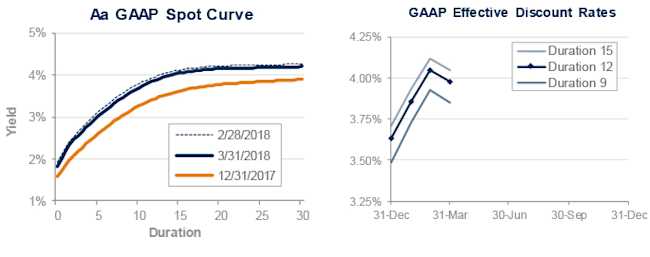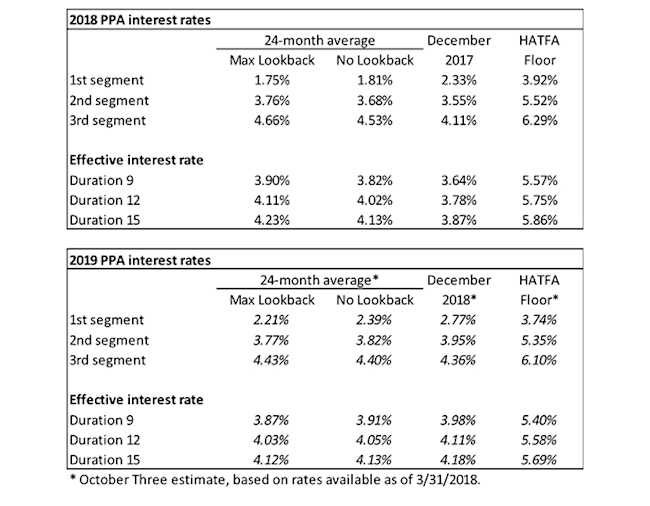
March 2018 Pension Finance Update
Pension sponsors saw funded status slip in March, due to lower interest rates and stock market losses. Both model pension plans we track1 lost ground last month- traditional Plan A lost 2% while the more conservative Plan B lost less than 1%. For the year, Plan A remains almost 3% ahead, while Plan B is up less than 1%:

Assets
Stocks were mostly down in March for the second straight month: the S&P 500 lost more than 2%, NASDAQ dropped 3%, and the overseas EAFE index fell by more than 1%, while the small-cap Russell 2000 managed to gain 1%. Through the first quarter of 2018, the NASDAQ remains up more than 2%, the S&P 500 and EAFE index have lost almost 1%, and the Russell 2000 is flat for the year so far.
A diversified stock portfolio lost 1%-2% in March and is now flat for the year.
Bonds added 1%-2% during March, as Treasury interest rates fell by 0.15% and credit spreads widened more than 0.05%. Treasury bonds and long-duration bonds performed best last month. For the year, a diversified bond portfolio is down 2%-3% through the first quarter.
Overall, our traditional 60/40 lost less than 1% in March and is down 1% for the year, while the conservative 20/80 portfolio gained less than 1% and is now down 2% after the first quarter of 2018.
Liabilities
Pension liabilities (for funding, accounting, and de-risking purposes) are now driven by market interest rates. The graph on the left compares our Aa GAAP spot yield curve at December 31, 2017, and March 31, 2018, and it also shows the movement in the curve last month. The graph on the right shows our estimate of movements in effective GAAP discount rates for pension obligations of various duration during 2018:

Corporate bond yields fell about 0.05% at most maturities in February, pushing pension liabilities up more than 1% on the month. For the year, liabilities are down about 3% – a bit less for short duration plans, a bit more for long duration plans.
Summary
After a strong January, during which stocks and interest rates rose, capital markets reversed course last month and pension sponsors have given back much of the early gains. Still, at the end of the first quarter, most plans are in somewhat better shape than at the close of 2017 on the strength of lower liabilities.
The graphs below show the movement of assets and liabilities for our two model plans so far this year:

Looking Ahead
Congress passed a budget in 2015 that includes a third round of pension funding relief since 2012. The persistence of historically low interest rates, however, means that pension sponsors that have only made required contributions will see contributions ramp up in the next few years as the impact of relief fades (barring an increase in long-term rates).
Discount rates fell 0.1% last month. We expect most pension sponsors will use effective discount rates in the 3.75%-4.25% range to measure pension liabilities right now.
The table below summarizes rates that plan sponsors are required to use for IRS funding purposes for 2018, along with estimates for 2019. Pre-relief, both 24-month averages and December ‘spot’ rates, which are still required for some calculations, such as PBGC premiums, are also included.

1Plan A is a traditional plan (duration 12 at 5.5%) with a 60/40 asset allocation, while Plan B is a cash balance plan (duration 9 at 5.5%) with a 20/80 allocation with a greater emphasis on corporate and long-duration bonds. We assume overhead expenses of 1% of plan assets per year, and we assume the plans are 100% funded at the beginning of the year and ignore benefit accruals, contributions, and benefit payments in order to isolate the financial performance of plan assets versus liabilities.
